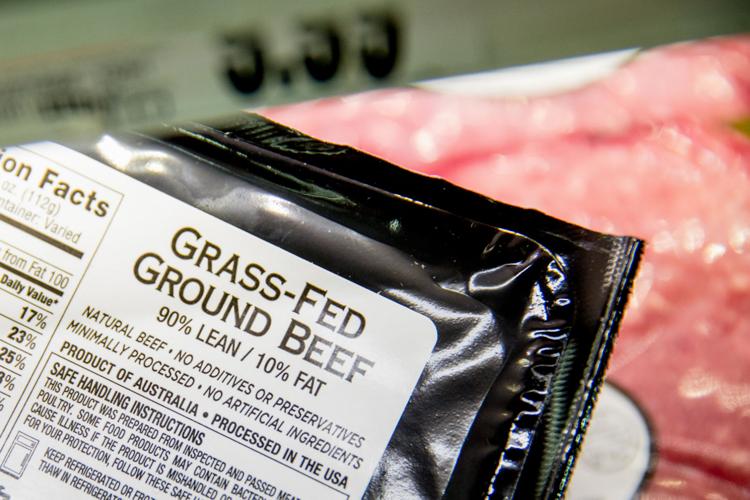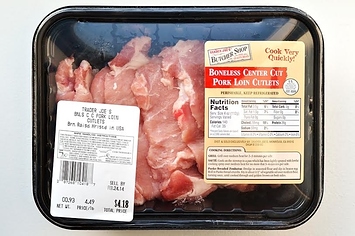39 country of origin meat labels
Country of Origin Labeling | Committee on Agriculture Country of Origin Labeling. "In order to avoid what could be devastating retaliatory sanctions against U.S. businesses if we lose, the starting point needs to be that mandatory COOL for meat is a failed experiment which should be repealed. The House Agriculture Committee is prepared to lead on this issue. Our goal, which is shared by industry ... What is the country of origin labeling for imported beef? The mandatory country of origin labeling of imported meat and poultry requires that if imported meat or meat products are intended to be sold intact to a processor, wholesaler, food service institution, grocer, or the household consumer, the country of origin labeling is conveyed to those market segments and recipients.
Country of Origin: What's in a Label? - The Beef Site A. Meat from these animals should be labeled as, Product of the U.S., Canada, and Mexico or Product of the U.S., Canada, Mexico. To provide consistency in the labels and to avoid consumer confusion, the terms "or" and "and/or" in the country of origin designation declaration shall not be used (e.g., retailers should not label their ...

Country of origin meat labels
Country Of Origin Labeling for Meat - Food Law Firm On September 11, 2013, a U.S. district judge refused to stop the USDA from requiring more specific country-of-origin labeling (COOL) for meat sold in U.S. stores. Formerly, federal regulations required U.S. retailers to label a product's country or countries of origin (i.e. "Product of U.S.A." or "Product of Canada and U.S.A."). Do You Know Where Your Meat Comes From? - EcoWatch Harris, who estimates at least 75 percent of the grassfed beef consumed in America comes from Australia, New Zealand or Uruguay, said American consumers are being intentionally misled. Millions of pounds of beef, imported from other countries, are being wrongly labeled as "Product of the USA," Harris said. USDA announces it will revisit country of origin labeling ... Cattle prices had risen since 2010, after country of origin labeling became mandatory, the petition reads. But by the end of 2015, the year the law was repealed, beef imports had skyrocketed by 33 percent, compared to the year prior. Because of that, the prices for domestic cattle fell by 30 percent, the petitioners wrote.
Country of origin meat labels. New rules on how meat is labeled: What you should know ... After more than a decade of wrangling, Congress repealed a meat labeling law last month that required retailers to include the animal's country of origin on packages of pork and beef. (Andrew ... PDF Country-of-Origin Labeling for Foods and the WTO Trade ... Mandatory country-of-origin labeling (7 U.S.C. §1638 et seq.): applies to ground and muscle cuts of beef (including veal), lamb, and pork, fish and shellfish, peanuts, "perishable agricultural commodities" as defined by the Perishable Agricultural Commodities Act (i.e., fresh and frozen fruits and Meat Labeling Law Repeal Leaves Buyers in Dark About ... In this photo taken May 19, 2015, meat labels are seen at a grocery store in Washington. It's now harder to find out where your meat was born, raised and slaughtered. After more than a decade of... Perdue takes the 'Made in USA' beef labeling option over ... Speaking to a Red Bluff, CA meeting with 75 northern California cattlemen, Bullard said there are two types of country-of-origin labels. A mandatory system, listing where an animal was "born,...
Senators resurrect country of origin labeling for beef ... The latest legislation will reinsert "beef" and "ground beef" into the current MCOOL law that requires country-of-origin labels on many food commodities, including meat from chickens, sheep, goats and deer. Country of Origin Labeling: MCOOL bill officially ... The 2002 M-COOL law passed in the 2002 Farm Bill and amended by the 2008 Farm Bill required country-of-origin labels on beef, lamb, pork, goat meat, chicken, fruits and vegetables, fish and shellfish, peanuts, ginseng, pecans, and macadamia nuts. After M-COOL's 2002 passage, implementation was delayed. Country of Origin Labeling for Meat Back on the Menu ... A previous origin labeling requirement for meat products was struck down by the World Trade Organization years ago and various efforts have been made since then to devise a policy compliant with WTO rules. On Jan. 3, as part of a new action plan for a "fairer, more competitive, and more resilient meat and poultry supply chain," the White ... Country of Origin Labeling (COOL) | Agricultural Marketing ... Country of Origin Labeling (COOL) is a labeling law that requires retailers, such as full-line grocery stores, supermarkets and club warehouse stores, to notify their customers with information regarding the source of certain foods. Food products covered by the law include muscle cut and ground meats: lamb, goat, and chicken; wild and farm ...
The Return of COOL? Legislation Would Resurrect Origin ... DailyYonder. Mandatory country of origin labeling (COOL) is back on the table with the American Beef Labeling Act, which would reinstate COOL for beef after its repeal in 2015. If passed, rancher advocates say profits of independent cattle producers could increase as consumers choose to buy U.S.-produced meat to support the nation's rural communities. House votes to repeal country of origin label requirement ... Canada and Mexico have opposed the labeling because it causes their animals to be segregated from those of U.S. origin -- a costly process that has led some U.S. companies to stop buying exports.... Country of Origin Labeling (COOL) Frequently Asked ... The abbreviations "P.R. China" and "China" are acceptable for country of origin marking purposes for products originating from the People's Republic of China. Either "Netherlands" or "Holland" is an acceptable abbreviation for The Netherlands. USDA announces it will revisit country of origin labeling ... Cattle prices had risen since 2010, after country of origin labeling became mandatory, the petition reads. But by the end of 2015, the year the law was repealed, beef imports had skyrocketed by 33 percent, compared to the year prior. Because of that, the prices for domestic cattle fell by 30 percent, the petitioners wrote.
Do You Know Where Your Meat Comes From? - EcoWatch Harris, who estimates at least 75 percent of the grassfed beef consumed in America comes from Australia, New Zealand or Uruguay, said American consumers are being intentionally misled. Millions of pounds of beef, imported from other countries, are being wrongly labeled as "Product of the USA," Harris said.
Country Of Origin Labeling for Meat - Food Law Firm On September 11, 2013, a U.S. district judge refused to stop the USDA from requiring more specific country-of-origin labeling (COOL) for meat sold in U.S. stores. Formerly, federal regulations required U.S. retailers to label a product's country or countries of origin (i.e. "Product of U.S.A." or "Product of Canada and U.S.A.").












Post a Comment for "39 country of origin meat labels"